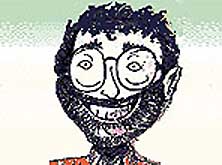Dr. Tad Hogg
Virtual 3D nanorobots could lead to real cancer-fighting technology said
“ Adriano Cavalcanti, Bijan Shirinzadeh, Robert Freitas, Jr., and Tad Hogg, representing institutions in Melbourne, Australia, and the U.S., have published their simulation procedure in a recent issue of Nanotechnology. Just as 3D simulations previously helped engineers greatly accelerate developmental research in the semiconductor industry, Cavalcanti and colleagues hope that virtual nanorobots, virtual biomolecules and virtual arteries will accelerate the progress of nanorobot development.‘The software NCD (nanorobot control design) is a system implemented to serve as a test bed for nanorobot 3D prototyping,’ Cavalcanti, CEO of the Center for Automation in Nanobiotech and researcher at Monash University in Melbourne, told PhysOrg.com. ‘It is an advanced nanomechatronics simulator that provides physical and numerical information for nanorobot task-based modeling. Serving as a fast development platform for medical nanorobots investigation, the NCD simulations show how to interact and control a nanorobot inside the body.’
‘One of the major factors for successfully developing nanorobots is to bring together professionals with interdisciplinary views of science and technologies,’ Cavalcanti said. ‘It is necessary to keep your eyes open for chemistry, materials engineering, electronics, computing, physics, mechanics, photonics, pharmaceutics, and medicine technologies. Our work is advancing progressively because we have experts from different backgrounds participating. We all pursue a common interest in working together to build medical nanorobots.’”
Tad Hogg, Ph.D. is a researcher at Hewlett-Packard Labs. His research interests include economic mechanisms such as ideas futures to improve organizations’ decision-making, experimental economics, distributed controls for microscopic robots built from molecular electronics and applications of quantum computing. Prior to coming to HP, he was at Xerox PARC where his work included an early market-based distributed computer system and robust controls for reconfigurable robots.
Tad holds a Ph.D. in physics from Stanford University and a B.S. in physics from Caltech and has written over 100 technical articles and book chapters on topics including human-subject experiments on eBay-like reputation mechanisms, quantum computer-based auctions and nanomedicine applications. He has served on the editorial boards of the Journal of Artificial Intelligence Research, International Journal of Modern Physics, and Autonomous Agents and Multi-Agent Systems.
Tad authored Coordinating Microscopic Robots in Viscous Fluids and Robust Self-Assembly Using Highly Designable Structures, and coauthored Mobile Microscopic Sensors for High-Resolution in vivo Diagnostics, Taking risk away from risk taking: decision insurance in organizations, How Well Do People Play a Quantum Prisoner’s Dilemma?, Controlling Tiny Multi-Scale Robots for Nerve Repair, Experimental Study of Reputation Mechanisms in an Exchange Economy, Defect-tolerant Logic with Nanoscale Crossbar Circuits, Assembling Nanoscale Circuits with Randomized Connections, and Experimental Implementation of an Adiabatic Quantum Optimization Algorithm.
His patents include Games using pair-wise entanglements, Distributed control system with global constraints for controlling object motion with smart matter, Electronic devices fabricated by use of random connections, Market based control of structural movement, System and method of determining latent demand for at least one of a plurality of commodities, Learning systems and methods for market-based control of smart matter, Distributed control of non-linear coupled systems with a single output, Nanometer scale devices, Reducing variation in randomized nanoscale circuit connections, Self-reconfigurable robot, Robust clustering of web documents, Distribution of partitionable physical properties for market based control of actuators and sensors, and Adaptive self-repairing processor array.
Watch his Google TechTalk Laboratory Experiments with Reputation Mechanisms For Electronic Commerce.
